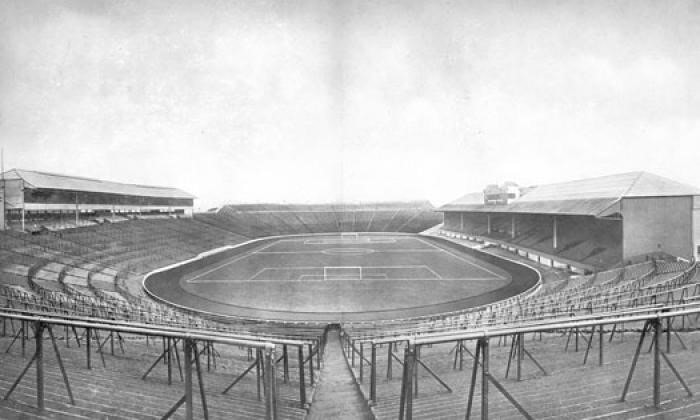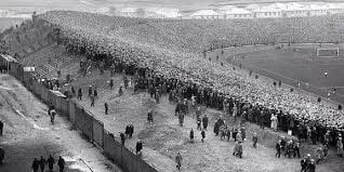Matters had come to a head that year after crowd scenes in Glasgow city centre before the international match with England. Supporters, anxious to get to Hampden Park before the gates closed, crossed working railway lines at Central Station as a short-cut to the trains heading for Mount Florida. Incoming trams were boarded before they had reached their terminus to ensure a place was secured for the return journey to the ground. At the ground there had been over-crowding.
Glasgow was already the football capital of the world, with Ibrox and Hampden each capable of hosting crowds of 120,000, with Celtic not far behind. It was still not enough.
The most likely threat from the Corporation would have been a significant reduction in the 120,000 capacity of Hampden Park and further changes to how the spectators entered the ground to avoid over-crowding. It is also possible that the Corporation may have looked at restricting public transport arrangements to avoid a repetition of the scenes in the city centre. These measures would have had a major financial impact on the SFA.
The SFA itself thought that the major games should be all-ticket with no tickets on sale on match day at the ground. This would aid control of the vast crowds and reduce the numbers travelling to the ground many of which would be locked out.
The SFA decided that the solution was to give one club sole right to stage the Scotland v England international and the Scottish Cup Final for a period of 21 years in return for committing to significant ground expansion plans.
It appears that Celtic FC, with a current holding capacity of 92,000, did not put forward a proposal for Celtic Park. In December 1905 the club had already withdrawn its own plans to host these major matches and supported the new (third) Hampden Park as the big match venue. It is possible that a survey of their ground revealed that they could not meet the SFA’s capacity requirement within their land or that plans would be economically unviable.
This left the way clear for Rangers FC and Queen's Park FC to submit proposals.
In 1930 Ibrox Park was certified to have a capacity of 136,941 but 120,000 was the match limit. Rangers had plans to increase the capacity to 150,000 together with spectator cover over the entire north enclosure. There were later reports of other plans to increase it further to 184,000.
Hampden Park had a certified capacity of 141,765 although again the match limit was 120,000. Queen's Park FC put forward two schemes that would increase the capacity to 167,720 or 163,472. Both schemes would give a realistic match limit of 150,000.
When the Council of the SFA met on 1 April 1936 to make its decision, there was a keen debate as there was little between the two proposals. Rangers' manager, Bill Struth, attended the meeting and asked many questions. He was keen to know what the position of the SFA would be if the Queen's Park FC plan was accepted but the club was later required to make a request for financial assistance - a pertinent question as you will find out. He also pointed out the Chief Constable's comments on the access improvements to Ibrox Park that would arise from the completion of the new Renfrew Road had been omitted from the report under consideration at the meeting.
In the end, the deciding factor was not the stadium plans, but supporter access. A letter from the London, Midland & Scottish Railway Company (LMS) informed the SFA that it could provide 20/25 special trains to Ibrox station on a match day but 45 using Mount Florida and King's Park stations near Hampden Park, with the latter leading to routes to the east. The company said that it could offer and manage a better service to Hampden Park. The decision was made.
Queen's Park FC agreed to provide the SFA with a stadium capable of holding 150,000 spectators for a period of 21 years. In return the club would receive one third of the receipts from the biennial international match against England, with a guaranteed minimum of £5,000 after deducting Entertainment Tax. The club would also receive 20% of the gate receipts from the Scottish Cup Final after deducting Entertainment Tax, match expenses, club guarantees and the percentage due to the SFA under the competition's rules. The SFA made it a condition that the admission price for the terracing for the match against England should be 2s (£0.10). One final condition was that if Queen's Park reached the Cup Final then the match would be played at Hampden Park, but Queen's Park would forgo its ground rent.
The Queen's Park club selected its slightly smaller scheme and engaged the famous Scottish football ground engineer, Archibald Leitch, to undertake the work. Glasgow, like each Scottish burgh, had a Dean of Guild Court made up of local magistrates, which at the time was the public authority to which anyone intending to build had to apply for permission, which they duly gave on 29 May 1936.
Construction started that summer and the extended ground was ready for occupancy on 15 February 1937 with the improvement costing £63,325. The original estimated cost was £40-50,000 but further unanticipated expenditure had been incurred to deal with safety requirements together with some other cost increases. It was a heavy financial burden for the amateur club and on 27 September 1937, after having received a deputation from Queen's Park FC, the SFA Council agreed to make a loan of £5,000, despite earlier requests for £10-12,500, to the club to be repaid over the period of the agreement to stage major matches. The annual interest rate was 2½%, paid half-yearly.
How many people could be safely accommodated watching a match was not the same as the theoretical holding capacity calculated by the engineers. The engineers assumed that every seat was occupied and then made a calculation of the space available (around a width of 18 inches) for spectators standing in serried ranks on each step of terracing. This produced a total of 163,782.
The engineers also calculated that an additional 19,906 spectators could stand in the gangways and that is the reason why a round 180,000 was often quoted at the time as the ground’s new capacity.
The match capacity was set and reviewed by the Glasgow Corporation based on advice from the Chief Constable, responsible for crowd control, and its Master of Works who made his own calculations. His result was 149,969 that was based on 14,269 seats and standing accommodation for 135,700. In his calculations 1.77 square feet per spectator was allowed for on the east terracing and 1.79 square feet on the west terracing with no standing in the gangways. The layout of the ground and its entrances and exits meant that 150,000 spectators could be admitted in under 75 minutes and it could be safely cleared in just 19 minutes.
When the expanded ground staged its first major matches in April 1937 new attendance records were set immediately. 149,547 attended the Scotland v England international on 17 April 1937, a new world record, which remains an all-time Hampden Park record and a European crowd record.
A week later, on 24 April 1937, 147,365 watched the Scottish Cup Final between Celtic and Aberdeen. This set an all-time Scottish Cup Final record and is still a record for a European club match. It was also a world record for a club match until December 1963 when 177,656 saw Fluminense play Flamengo in the Maracanã.
Soon afterwards a meeting of the Glasgow Corporation was held on 27 May 1937 to discuss concerns over safety at the ground and heard claims that the passageways were blocked and there had been overcrowding and swaying. The Corporation received reports from the Master of Works and the Chief Constable and were keeping in mind possible further improvements. Councillor David Brown, who had watched the International match from the east terracing, argued that the match capacity should be reduced to 135,000 and other aspects of crowd control and ground layout needed to be addressed. However, no change was made.
In 1938 Hampden Park was not hosting the England match and the Cup Final opponents (East Fife and Kilmarnock) meant that ground capacity was not going to be taxed. The issue arose once again the following year. On 4 April 1939 the Glasgow Magistrates met and discussed the capacity for the forthcoming international match against England and the Cup Final. It was again suggested that it should be reduced to 135,000 to ensure safety and comfort but in the end it was set at 149,000. That was the capacity calculated by the Master of Works and subject to the installation of some more crush barriers before the international.
149,269 attended the Scotland v England match on 15 April 1939.
Hampden would never witness such large crowds again. For much of the Second World War the ground operated under a reduced capacity. 139,468 watched the Scotland v England Victory International on 13 April 1946 that was played a month after the Bolton disaster when 33 spectators lost their lives, and hundreds were injured. The public enquiry into the disaster made a number of safety recommendations and consequently, the Hampden Park capacity was reduced to 134,580 where it remained for many years.


 RSS Feed
RSS Feed